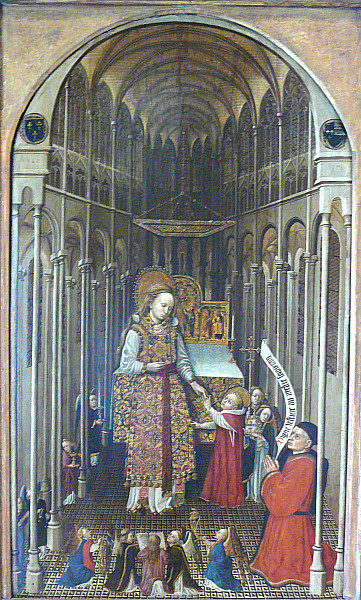
The Master of the Collins Hours
Le Sacerdoce de la Vierge
1438
The Louvre
The image's title means "The Priesthood of the Virgin." This unusual image puts the Virgin Mary in the garb of a priest at Mass, standing at an altar with a Gospel Book in her right hand. Her left hand holds that of a child, who tugs at her garment with his right. (We take the child to be Christ, though his halo does not have the usual cross on it.)
The theology of the image may be understood in the words on the banner next to the kneeling donor: Digne vesture au prestre souverain, "Vestment worthy of the sovereign priest." In the French, "priest" is grammatically masculine, so it refers to Christ, not Mary; she is the "vestment" worthy of bearing the Son of God, who will be both priest and victim in the sacrifice of Calvary.
The Gospel Book that Mary carries in the image supports this incarnational theme. The gospel is God's Word, just as Christ is the eternal "Word made flesh" of John 1. Mary "carries" both. Moreover, the French word "carry" also means "wear," so in wearing the priestly garments she is again "carrying" the Sovereign Priesthood that is her son.
The child's tugging at the priestly vestment has a double value. It "humanizes" him in giving him a gesture common to children that we know in daily life. But it also represents the eagerness of the Son of God to take up his destiny as priest and victim in the sacrifice that will save mankind, the sacrifice that the Mass recalls. This combining of "humanizing" features with foreshadowings of the Passion is seen in many Madonna and Child images of the time – for example, the Veneziano Madonna in which the child plays with a goldfinch whose red marking looks forward to the blood he will shed at the Crucifixion.
Another contemporary work with a similar weaving together of Marian and incarnational themes is the English "I Sing of a Maiden that is Makeles," which closes with the paradox, "Well may such a maiden God's mother be."
Read more about portraits of the Virgin Mary.
Photographed at the Louvre by Richard Stracke, shared under Attribution-NonCommercial-ShareAlike license.